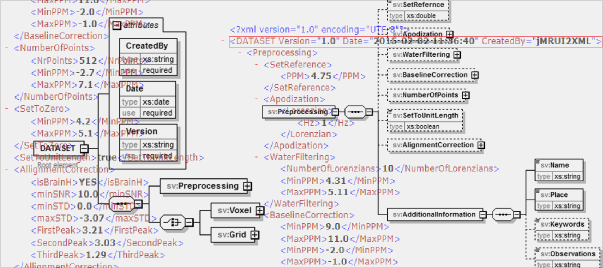From raw data to data-analysis for magnetic resonance spectroscopy – the missing link: jMRUI2XML.
Victor Mocioiu, Sandra Ortega-Martorell, Iván Olier, Michal Jablonski, Jana Starcukova, Paulo Lisboa, Carles Arús and Margarida Julià-Sapé.
BMC Bioinformatics 2015, 16:378
DOI: 10.1186/s12859-015-0796-5
Abstract
Background
Magnetic resonance spectroscopy provides metabolic information about living tissues in a non-invasive way. However, there are only few multi-centre clinical studies, mostly performed on a single scanner model or data format, as there is no flexible way of documenting and exchanging processed magnetic resonance spectroscopy data in digital format. This is because the DICOM standard for spectroscopy deals with unprocessed data.
The paper proposes a plugin tool developed for jMRUI, namely jMRUI2XML, to tackle the latter limitation, given that jMRUI has evolved into a plugin platform allowing for implementation of novel features.
Results
jMRUI2XML is a Java solution that facilitates common preprocessing of magnetic resonance spectroscopy data across multiple scanners. Its main characteristics are: 1) it automates magnetic resonance spectroscopy preprocessing, and 2) it can be a platform for outputting exchangeable magnetic resonance spectroscopy data. The plugin works with any kind of data that can be opened by jMRUI and outputs in extensible markup language format. Data processing templates can be generated and saved for later use.
The output format opens the way for easy data sharing- due to the documentation of the preprocessing parameters and the intrinsic anonymization – for example for performing pattern recognition analysis on multicentre/multi-manufacturer magnetic resonance spectroscopy data.
Conclusions
jMRUI2XML provides a self-contained and self-descriptive format accounting for the most relevant information needed for exchanging magnetic resonance spectroscopy data in digital form, as well as for automating its processing. This allows for tracking the procedures the data has undergone, which makes the proposed tool especially useful when performing pattern recognition analysis. Moreover, this work constitutes a first proposal for a minimum amount of information that should accompany any magnetic resonance processed spectrum, towards the goal of achieving better transferability of magnetic resonance spectroscopy studies.
© 2015 – 2018, MRUI Consortium. All rights reserved by MRUI Consortium except for texts and images already copyrighted by third parties (e.g. journal publishers) and used here according to their licensing terms and/or under the fair use provision.
